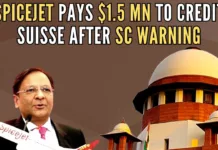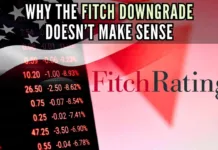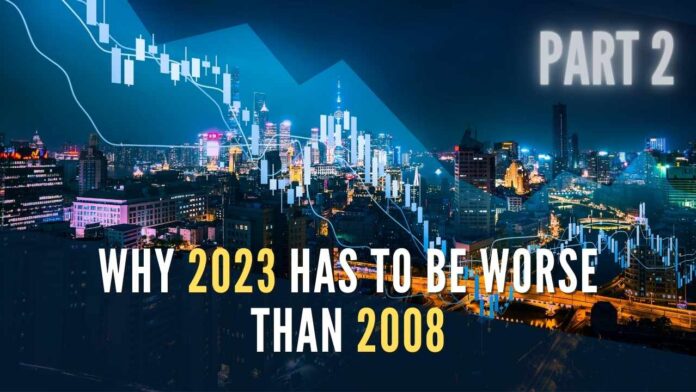
The previous first part of the article can be accessed here Part 1. This is Part 2
Stars aligned for a 2008-style crash
When I wrote Why 2023 has to be worse than 2008 – Part 1 in the first week of Jan 2023, there was little doubt in my mind that the US would witness the start of an “Implausible Keynesian Abyss” this year. As I had written in that article, what will happen in 2023 and the years ahead will make the 2008 GFC look like the proverbial Sunday school picnic.
The stars are indeed aligned for a 2008-style crash. The equity, bond, and crypto markets had collapsed into a bear market on account of the US Fed rate hikes during 2022 (which incidentally I had forecasted as well 2022 – It is different this time). It was only a question of time before real estate entered into one dragging down the banks with it. Just to recall, the US housing real estate had witnessed a 40% correction post the 2008 crash over the subsequent 6 years. We will witness an even larger and extended crash in the years ahead. The housing bubble 2.0 is substantially bigger than the 2008 bubble and the Fed backstopping tool of ZIRP is not an option anymore – courtesy, the consumer price inflation.
Let me start by defining the phrase “Implausible Keynesian Abyss” – IKA. It is going to be an extended period of high inflationary recessions with sporadic quarterly bursts of positive growth and disinflationary patterns. The summation of annualized CPI + GDP contractions is going to be in double digits for years to come. Steeped in the fallacy of Keynesian economics and the Phillips curves, most economists cannot conceptualize a combination of a recession and inflation, but that’s exactly what lies ahead.
Can anything be done at all to prevent this scenario? People who understand Austrian Economics will know that recessions caused by the liquidation of malinvestments have to be proportional to the size of the artificial credit-induced bubble. We have an unprecedented bubble because of 15 years of ZIRP and QE. Not to forget the Greenspan years before that. So there is no escaping the recession – and a deep extended one at that.
But the high inflation part of the IKA is a choice and that will be a consequence of the actions of the US Fed. Monetary inflation i.e. the expansion of the money supply will be the only solution to every problem (such as the SVB collapse) and this is a playbook that has been demonstrated over and over again by most central banks around the world and even more particularly the US Fed. Every Institutional loss will be socialized and the effects will be seen on the purchasing power of the US Dollar. SVB, Signature Bank, and Credit Suisse are just the start – perhaps only the 1st or 2nd of a 9 innings baseball game.
Before expanding on what is likely to happen in the years ahead in terms of the fiscal and monetary response of the US government, we can afford to fantasize for a fleeting moment about what the right thing to do would be. I would list the steps in terms of increasing order of what Austrian Economics would dictate. But there is no hope that even the first step would be initiated, let alone go down the path of lassiez-faire economics, individual freedom, and liberty.
- Increase interest rates to offer a positive yield and run a balanced budget to free up capital for private sector investments.
- Re-open the Gold Window that was abolished by Nixon in 1971 to offer convertibility of the US Dollar to Gold for other Central Banks (the price of Gold would have to be at least 5X the current market price).
- Allow convertibility of currency to gold for citizens – a practice that was banned by Roosevelt in 1933 under the cover of the Great Depression.
- Abolish the US Federal Reserve (formed in 1913) and return to the classical Gold standard where banks are free to issue their own currency and interest rates are market determined. Money is just way too important a market function to be left to the dictates of governments.
But as I said myself, the above is sheer fantasy bordering on hallucinations, and there is not a chance of even the first step being initiated by the US Fed, let alone traveling down this path.
That said, the current worldwide problem of inflation can and will eventually be solved by China opening a Gold window. In the aftermath of the US Dollar collapse, it is hard to envisage a situation where markets start to believe in another government’s – and that too a supposedly communist one at that – promise of a non-inflationary monetary system. With an estimated 30 to 40,000 tons of Gold held by the Chinese central bank and massive trade surpluses that create a genuine market demand for the Yuan, no currency is better positioned to take over the mantle from the US Dollar.
Returning to the reality of the US Fed and perpetual inflation, let us now focus on what is likely to happen to the US Economy rather than what should ideally happen.
Housing Bubble 2.0 burst right ahead
- Median Housing Prices: Housing prices peaked during May – June 2022 and have been on a downward trend for the last 7 months. From the peak, median prices are down by about 10% and while it is still officially not in a bear market, it’s a question of time before housing dips into one as well.
- US 30-Year Fixed Mortgage Rates: Prior to mid-2022, the 30 Year fixed mortgage rates averaged between 3 and 4% for the preceding 4 years and this low rate has steadily fueled the increase in housing prices. From then on, the rates had steadily increased to 7%+ by the end of 2022 and have been hovering around 6.5% for the first quarter of 2023. This increase roughly translates into a 30% increase in EMI for the same housing sale price.
- US Building Permits: Housing permits typically have been a good forecaster of downturns in the housing market. In line with the above 2 factors, the US building permits peaked at about 1.9M units during mid-2022 and are now down to 1.3M indicating a near 30% decline in permits over this period.

What history tells us is that there is a 12 to 24 months lag between the hike in rates and for the effect to show up in housing prices. We have seen that with the 2008 crash and the mild downturn in 2018. As can be seen, the increase in prices has been substantial over the last few years and with the near-historic pace of rate increases, a crash in housing prices is imminent. à la 2008.
How about rate cuts to prevent the housing crash?
Substantial rate cuts are unlikely. The current round of monetary stimulus is going to primarily be in the form of QEs rather than rate cuts. Not on account of any principle though. The US Fed still has the daytime job of pretending to be the fireman dousing the fire of inflation by holding rates well above zero. Of course, these rates will not be anywhere close to offering a positive real yield.
At the same time, the US Fed would also be performing the role of the Arsonist in stoking the fire of inflation through QEs. Maybe, they might even discontinue publishing the M2 numbers in the not-too-distant future. After all, it was not too long back that they discontinued publishing M3 numbers. The official reason was that it was very expensive to calculate M3; for an agency that can print money at will, isn’t that a bit strange?
Paraphrasing the inimitable Jim Grant, the dual mandate of the Federal Reserve now has an entirely new defacto interpretation – the Arsonist and the Fireman.
No doubt, the fireman doesn’t stand a chance in front of the Arsonist.
QE Tsunami ahead – The Grand Fed U-Turn
In the bailout speeches of SVB, both Yellen and Biden stressed the fact that the taxpayers will not face the burden. That in fact, has been the primary reason for the US Economy’s IKA status today. Every expansion of the US government over the last few decades has been funded surreptitiously by monetary inflation rather than through the legitimate source of taxation.
If the US government had to fund its various guns and butter programs through taxation, these would have been non-starters. Deficit spending just allowed the US government to confiscate the required sums in a very insidious way. As the maestro Greenspan uncannily remarked in his missive Gold and Economic Freedom “…Deficit spending is simply a scheme for the confiscation of wealth. Gold stands in the way of this insidious process. It stands as a protector of property rights. If one grasps this, one has no difficulty in understanding the statists’ antagonism toward the gold standard.”
The ultimate effects of deficit spending, i.e. consumer price inflation, are often times delayed. Unfortunately, today happens to be the payback time for all of the US Fed balance sheet expansions that have occurred since 2008. On top of this, imagine the QE that would be launched to handle the 2023 bailouts – these would dwarf the size of the earlier rounds of QE.
Here are 110 years of the US Fed balance sheet expansions summarized in a few lines:
- For the first 95 years since its formation in 1913, the Fed’s balance sheet size was less than $1 trillion.
- Even within the period 1913 to 2008, 1971 was a decisive turning point. The balance sheet that was much less than $100B in 1971 witnessed more than a 10-fold increase over the next 35 years leading up to 2008.
- The next nearly 10-fold increase that starts with the GFC happens in a much shorter period i.e. 14 years. By Apr 2022, the balance sheet nearly touches 9 trillion.
- How long will it take for the next 10-fold move i.e. the US Fed balance sheet to reach $100 T?
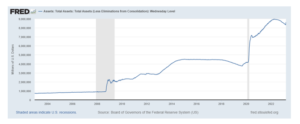
The events of the last few days might give an indication. Given below is the same graph but only for the last 6 months i.e. when the latest and perhaps the last official QT was attempted. The last 3 and half months of QT have been erased in just 1 week of QE.
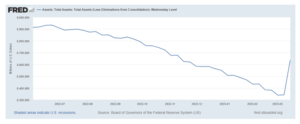
Now we can go back to the literal $100T question. If history and the track record of the current set of policymakers are any indications, it ought to take much less than 14 years. Somewhere around 2030 – give or take a couple of years. Most would dismiss this idea of a $100T Fed balance sheet, but then how many would have even contemplated a 10X in the last 15 years?
That the CRB Index fell by more than 80% (between 2008 and 2020) when this expansion happened will undoubtedly be a reason why the US Fed will attempt monetary inflation as a solution again. Sadly, history in this case is certainly not going to repeat – not even rhyme.
This incidentally happens to be the monetary policy of banana republics like Zimbabwe and Argentina. As I see it, hyperinflation is not only a possible event for the US Dollar, but a probable one. Maybe even the most likely outcome as well. We are not far from the day when the US Dollar will be re-christened as the US Peso.
Note:
1. Text in Blue points to additional data on the topic.
2. The views expressed here are those of the author and do not necessarily represent or reflect the views of PGurus.
PGurus is now on Telegram. Click here to join our channel and stay updated with all the latest news and views
For all the latest updates, download PGurus App.
- 2008 Redux? YES and NO - October 23, 2023
- Is there a conundrum in the US Housing Market? - September 21, 2023
- Why the Fitch downgrade doesn’t make sense - August 14, 2023


